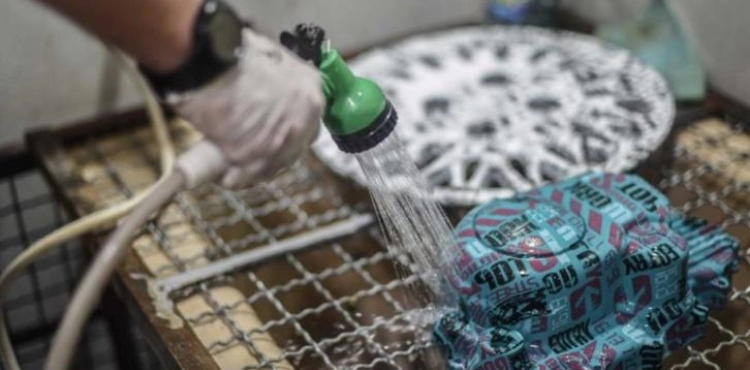The young Omar Khaled Al-Asouli (25 years old) succeeded in introducing water printing to Gaza for the first time through his own project, which challenged the reality of unemployment and the scarcity of job opportunities for young graduates in the besieged Strip.
Water-based printing, which depends on printing solid objects by immersing them in water and using beautiful pigments and pre-prepared templates, in which the young man, Omar, found a job opportunity, providing him with a stable source of income, especially in light of the stifling economic conditions that the Strip suffers from, to form an inspiring model that motivates aspiring youth in Gaza To face their tough life challenges and make their way on their own.
Al-Assouli, who obtained a bachelor´s degree in electronics engineering in 2017, said in an exclusive interview with "Al-Quds": "This idea came to me after I graduated from university and looked for a job opportunity for 3 years and I did not find so I thought about looking for an alternative field of work to find a source of livelihood for me and my family, so I turned To create an unconventional project that is not present in the sector and has a high success rate, so I was optional for a water-printing project. "
Regarding the details of his project, Al-Asouli, who lives in Khan Yunis, in the south of the Gaza Strip, adds: "Water printing is one of the modern projects in the Arab world, which has proven its resounding success in a short period not exceeding five years. Therefore, my project, which I called" Aqua Magic Water Printing ", , The first project of its kind in Palestine specialized in this field. "
Al-Assouli continues: "I first worked in my home after I learned water-printing via the Internet, then I opened a store in Khan Yunis last December after I brought special equipment for this printing, either from Gaza or importing it from abroad because it was not available, and the turnout was before Customers are a little bit in light of the society’s culture that does not tend to new things and is afraid to risk their money, even though most of the things that we trade are printed in this way, such as car dashboards and metal tires.
And Cheb Al-Assouli points out that water-based printing is based on printing several materials such as (iron, gypsum, wood, and car tires), and all objects that can be submerged in water, using beautiful dyes and molds.
He explains that he deals with many segments of customers such as drivers, company owners, shops and others, indicating that the target market in the project are cars, motorcycles, bicycles, alumetal, metals, wood, plastic, fiber, gypsum, pottery, and glass. Leather, tools, household tools, antiques, antiques and many more.
Regarding the difference between regular and water-based printing, he says that the latter is characterized by its strength and very high rigidity, like car paints, and it is also printed on objects that have many curves and which are not suitable for regular printing.
Al-Assouli added to the "Al-Quds" correspondent that water-based printing is a paint like car paint or docu paint that does not peel off and is not affected by the sun or by various weather factors and has no default life, explaining that water printing or dipping is a modern paint technology like any paint in the world, but Painting or painting is done through water, and this is what is new and distinctive in this field.
He says that water-printing gives quality, stability, protection, aesthetics, and lifespan more than Doku paints for cars, indicating that it can be applied to any object or material, regardless of its condition, whether new or old or used, as it can be used on old bodies and transformed into new bodies in an impressive and distinctive way. .
Al-Asouli notes that printing or dipping has existed for a long time outside the Middle East and is known to us as formica or woodworking, which is what is found in the fiber parts in the car salon which are in the form of wood or formica, and it is available on many procedures in homes and daily life.
Regarding the financial cost of his project, he explains that his project only cost him a printing tank, water-printing films and the activating substance, explaining that its prices are suitable for everyone.
He points out that painting the metal car tire kit costs from 350 to 400 shekels, and in watercolor printing it is only 50 shekels more expensive, and their water-based printing is characterized by strength and stiffness, in addition to its distinction of different shapes and graphics.
Regarding the most prominent obstacles that he faced in his project, Cheb Al-Assouli says: "The introduction of the necessary materials and equipment in my work, such as printing films and water-printing activators for the Gaza Strip, is one of the most obstacles that I faced, but thanks to God we were able to find an effective and highly efficient alternative, and we aspire in the future to be able to manufacture These films are inside Gaza. "












